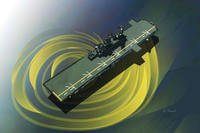This story, part of a series of reporting projects by Military.com on service member and veteran health, was supported by the Pulitzer Center. You can read our first story on missileer cancer concerns here and our second story on maintainers' health worries here.
A new independent research report examining non-Hodgkin lymphoma cases among service members who worked with nuclear missiles at Malmstrom Air Force Base in Montana suggests that it's very unlikely that the high rates of blood cancer would have occurred by chance.
Researchers at the University of North Carolina at Chapel Hill, in the unpublished report, analyzed data provided by the Torchlight Initiative, a grassroots group of current and former missileers who have created a cancer registry for those who worked on intercontinental ballistic missiles, or ICBMs. The report's findings, first provided to Military.com, showed that "the probability of 18 missileers within the study population being diagnosed with [non-Hodgkin lymphoma] is 2.1 in 1,000 trillion or extremely unlikely to be due to chance," the Torchlight Initiative said in a statement.
"This analysis underscored the exceptionally low likelihood of such events occurring purely by chance, suggesting potential underlying risk factors or exposures unique to this population," the findings of the research paper, shared by Torchlight on Monday, stated.
The paper, titled "ICBM Community Cancer Registry Analysis: A Focus on Non-Hodgkin Lymphoma Cases in Missileers," used the Torchlight registry -- which consists of more than 635 reported cancer cases among the community -- and compared it to national rates in the National Cancer Institute's Surveillance, Epidemiology and End Results Program, or SEER. The new report was not authored or sponsored by the Department of Defense, the Air Force or the U.S. government.
Torchlight said the results show that non-Hodgkin lymphoma is occurring at higher rates and at younger ages than the national average.
"This decision-worthy evidence means that missileers are taking casualties at an unacceptable rate," Torchlight said in a statement. "Now that the community sees evidence of the problem at Malmstrom, steps need to be taken to understand the scope of the problem, the cause or causes, and to mitigate the risks immediately."
Concerns of non-Hodgkin lymphoma and other cancers among missileers and maintainers have been detailed in an ongoing Military.com investigative series examining how service members were working in conditions with known carcinogens and chemicals that they now believe contributed to the health issues.
While the university's report also states that the "modest population size constrains the power of our analyses," it also serves as the first independent analysis of cancer data released since the Air Force announced last year that it was probing the concerns among current and former members of the service's nuclear missile community.
That independent research matters a lot to former missileers such as 47-year-old Michael Yamzon, a recently retired missileer who was stationed at both F.E. Warren Air Force Base in Wyoming and Malmstrom in the 2000s. During his career, he started experiencing breathing problems and, last week, was diagnosed with mesothelioma, which he attributes to his time in the Cold War-era facilities.
Yamzon said it's important for outside eyes to examine the cancer rates to come to a truly objective conclusion.
Military.com's investigation showed that prior studies by the Air Force in the early 2000s ignored potential warning signs of cancer clusters among the community, and that the military branches failed to account for known contaminants in the past.
"The Air Force is investigating itself. Are they really interested in doing a thorough investigation? Or is that contradicting. … There's always that doubt on the validity of the depth and the accuracy of the investigation," Yamzon said in an interview with Military.com. "Torchlight has nothing else better to gain other than the advocacy for the health of people, the missile community."
Torchlight's independent report comes as the Air Force is undergoing a massive cancer study of its own that began in 2023 -- after a former Malmstrom missileer and current Space Force officer created a presentation that showed an alarming number of cancer cases among those who served at the base.
Air Force Global Strike Command provided a statement but did not comment specifically on the new research shared by the Torchlight Initiative when reached by Military.com for comment on Monday.
"Our epidemiological study, based on tens of thousands of records, continues to move forward," said Charles Hoffman, a command spokesman. "We expect the results of the next phase of the study to be released at the end of summer."
So far, only preliminary data has been released from the service's study that points to some elevated levels of cancer among the missile community. But the Air Force is still working to gather data from Department of Veterans Affairs medical records, the Department of Defense cancer registry, and the VA cancer registry.
Last month, Air Force Global Strike Command detailed several changes coming during the course of the study, including new workplace inspections and having hazards and exposures added to missileers' records.
The Air Force has done testing at F.E. Warren, Malmstrom and Minot Air Force Base in North Dakota, as well as Vandenberg Space Force Base in California.
While missileers and maintainers have told Military.com they were exposed to numerous substances, the Air Force has found only carcinogenic polychlorinated biphenyls, or PCBs, above the Environmental Protection Agency's threshold in facilities at two of the bases, Malmstrom and Minot.
The launch facilities, the underground silos where the actual missiles themselves are kept, at the three operational bases -- F.E. Warren, Malmstrom and Minot -- had not been tested but are scheduled for testing this month.
"I want the Air Force to recognize what they are doing to their airmen," Yamzon said. "They are subjecting their people to an environment that is not acceptable, and they need to do something to remove those toxins to allow people to operate in an ideal condition."







